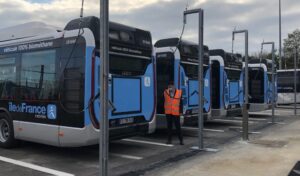
Ile-de-France Mobilités has decided to accelerate the energy transition of buses throughout the Region, making the Ile-de-France a world reference for very low-carbon urban public transport.
It is in this context that the territory of Cergy-Pontoise (close to Paris) benefits from the renewal of 50 standard buses and 6 articulated buses running on biomethane. (Ile-de-France Mobilités
is the authority that controls and coordinates the different transport companies operating in the Paris-area and rest of Île-de-France region public transport network )
Initiated in 2019, the energy conversion of the Bus Operational Centre in Saint-Ouen-l'Amône, operated by STIVO (Société de Transport Interurbaine du Val d'Oise), was completed in December 2020. This project of energy transition to biomethane was decided and financed by Ile-de-France Mobilités, with an investment of 3.7 million euros for infrastructure (excluding vehicle costs).
Methanization, which involves leaving organic waste moist in an oxygen-deprived atmosphere, provides biomethane on the one hand, and fertilization for soils and plants on the other. Biomethane is therefore a more virtuous and responsible energy than fossil fuels since it is the result of the transformation of local organic waste. It is this energy that is used by Ile-de-France Mobilities for its vehicles.
The conversion of the Saint-Ouen-l'Amône Bus Operational Centre consisted of connecting the site to the GDRF gas network, installing a gas compression station, installing a gas distribution system at each bus parking space and upgrading the bus maintenance workshop. Buses can also be refuelled in minutes thanks to a fast fill gas station.
Thanks to this work and equipment, the first buses entered circulation on Monday, December 14, 2020.
50 new standard buses and 6 new articulated buses are being delivered and will replace old diesel vehicles. Travellers will gradually benefit from more environmentally friendly vehicles and better on-board comfort.
Together with the smootheness and silent operation of the new Gas Vehicles, they also have other advantages, such as:
1. A new interior design designed and innovative to improve the reception and comfort on board passengers:
1. Anti-vandalism fabrics, less messy
2. USB ports available to travellers
3. Electric accessibility ramps to facilitate the rise of wheelchair users (UFR) as for all buses of Ile-de-France.
4. On-board lighting - natural and soothing
5. 3rd rear door on standard buses to facilitate passenger flows
6. The opening of doors accessible by self-service to the ascent and descent by the travelers themselves
7. Weather vanes - e-mail messages of information on bus destinations - colorful and bright for more efficient tracking of bus routes
STIVO teams have been trained on new infrastructure, new vehicles and associated new maintenance.
The use of biomethane makes carbon neutral or carbon negative transportation a reality, here and now. If by any reason biomethane is not available or not enough, the same infrastructure and vehicles can use fossil natural gas, or blends of bio and fossil without any need for modifications. Natural gas has been called a transition fuel to cleaner more sustainable fuels. The cleanest and most sustainable fuel in sight is precisely biomethane, which converts an environment liability (urban waste) into clean biomethane that replaces fossil diesel.
Source: Ile-de-France Mobilités
